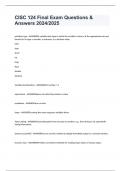Exam (elaborations)
CISC 124 Final Exam Questions & Answers 2024/2025
- Course
- Institution
CISC 124 Final Exam Questions & Answers 2024/2025 primitive type - ANSWERSA variable data type in which the variable's value is of the appropriate size and format for its type: a number, a character, or a boolean value. Char byte short int long float double boolean Variable decele...
[Show more]



